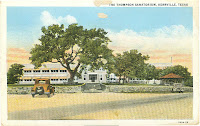 |
Handbook, Kerrville State Sanatorium, late 1930s
Click on any image below to enlarge. |
Here’s a story from my files, first published in 2007, which appears below in an edited and updated form:
I should not be surprised by the sheer amount of local history I do not know. Someone will occasionally bring me something and I’ll think to myself, “Hmm. I had no idea.”
A few months ago a friend emailed me a simple question: was the Kerrville State Hospital ever a tuberculosis sanatorium exclusively for African-American patients?
Many local families can trace their arrival in Kerr County to some family member who was ill with tuberculosis. The J. E. Grinstead family, or the Charles Butt family, for example, back in the early part of the last century, moved to Kerrville because a family member was ill. Father Henry Kemper also came here to find health, as did Kerrville’s third mayor, George R. Parsons.
Turns out Mr. Joe Lewis’s family can also trace its arrival here due to the illness: Joe Lewis himself was a victim of the disease, arriving here as a lad of six.
 |
| Dr. and Mrs. H Y Swayze |
What is now the Kerrville State Hospital started out as a dude ranch called “My Ranch.” After the dude ranch closed, around 1915 a sanatorium opened on the site called “Mountain Park Sanatorium.” Dr. Sam E. Thompson purchased the property in 1917, and renamed it “Thompson Sanatorium.”
 |
| "My Ranch" dude ranch |
You might notice an old relic of the early days of the dude ranch and sanatoriums when you’re crossing the Guadalupe River on the Francisco Lemos Street Bridge. Look just downstream, and in one of the cypress trees you’ll see an old power line arm, dotted with insulators, the remnants of the power line which served the dude ranch; in the riverbed you’ll see the hints of an old low-water crossing, which I believe was built by the owners of My Ranch for its guests.
 |
| Mt View Sanatorium |
Dr. Thompson operated the facility until 1936, when the property was acquired by the State of Texas for $80,000. In her entry on the hospital’s history in the Handbook of Texas, Sue Low writes “the previous year the Forty-fourth Texas Legislature had appropriated $200,000 for the establishment of a tuberculosis hospital for black patients. On June 1, 1937, the facility opened as the ‘Kerrville State Sanatorium;’ it was under the direction of Dr. H. Y. Swayze. In 1949 the sanatorium was closed and all of its patients transferred to the East Texas State Tuberculosis Hospital in Tyler.”
 |
| Thompson's Sanatorium |
Mr. Lewis has a small booklet given to him when he was a patient there – the cover reads “Kerrville State Sanatorium, an institution located at Kerrville, Kerr County, Texas, for the Treatment of [African-American] Citizens of Texas.” The front page adds the blurb “Located in the hills of Kerr County, facing the Guadalupe River.”
The booklet has 20 pages, complete with photographs. There are photos of the hospital facility and staff and there are photos of patients, including a very touching photo of children patients.
 |
Nurses, Kerrville
State Sanatorium |
The booklet says that “the primary purpose of the institution is to provide six months’ treatment for all early cases of tuberculosis among the [African-American] citizens of the State of Texas, and also to train all patients so that they may return home at the expiration of their allotted time to complete their treatment. During their stay at the institution, they are taught how to keep from spreading the infection among others with whom they may come in contact after their return home.”
 |
Young patients, Kerrville
State Sanatorium |
A note from the Superintendent and Medical Director, Dr. H. Y. Swayze, says “the State of Texas … has erected a large modern sanatorium for the treatment of its tuberculous citizens…. This hospital was built and is operated for the purpose of alleviating sickness and suffering. Every effort will be made to fulfill this great responsibility and trust.
According to Sue Low’s piece in the Handbook of Texas, “The facility was reopened by the state in May 1951 as a branch of the San Antonio State Hospital, serving 119 geriatric women with mental illness. On September 1, 1952, it became a separate entity, known as Kerrville State Home. By 1959 the hospital had grown to serve 1,200 resident patients; it had buildings located on 41 acres with an adjacent 258 acres that included a small lake. That same year the Texas legislature changed the name to Kerrville State Hospital.”
Until next week, all the best.
Joe Herring Jr. is a Kerrville native who is aware how little he really knows about local history. This column originally appeared in the Kerrville Daily Times February 9, 2019.
Joe's latest book is available at Wolfmueller's Books, 229 Earl Garrett, in downtown Kerrville. His books are also available at Herring Printing Company and online, by clicking HERE.









WOW.... nice column, I knew about the TB Hosp, but not that it was for Blacks. Thanks for informing us......
ReplyDeleteI wish I could get more information. My grandfather died at this facility during that time.
ReplyDeleteGreat black history��
ReplyDeleteI was told by my father that his mother died of tuberculosis when he was only 12 years old. Apparently, that was not true. He was unaware that his mother was alive until 1948. For instance, I just discovered her diary, she was alive in 1948. The hospital closed in 1949 and transferred to East Texas Tuberculosis Hospital in Tyler, Texas. Ironically, my dad and sister went into the medical field to become abreast of tuberculosis. Not only that but my dad went to Texas College in Tyler, Texas and later worked at the East Texas Tuberculosis Hospital. How do I go about locating her records and her death certificate?
ReplyDelete